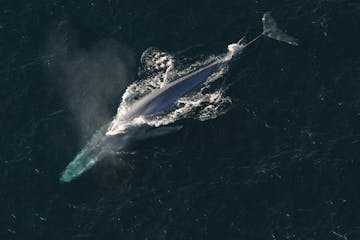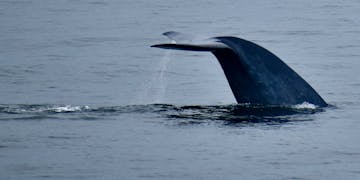At more than 30 meters (100 feet) long and weighing almost 181 metric tons (200 tons), the blue whale (Balaenoptera musculus) is the largest animal to ever have lived on Earth. Despite its large size, many questions about the natural history and ecology of blue whales remain unanswered.
Commercial whaling decimated blue whale populations. Global protections seek to safeguard this species, yet blue whale populations remain endangered. This magnificent mammal must navigate a web of threats—ship strikes, entanglement in fishing gear, and noise that interferes with communication. To inform protection and support population recovery, resource managers require a thorough understanding of the ecology of blue whales.
The northeastern Pacific Ocean supports the planet’s largest population of blue whales, which annually migrate thousands of kilometers between northern cold-water foraging habitat and southern warm-water breeding habitat. To better understand their behavior and help inform their protection, MBARI researchers will deploy a new observatory to study the blue behemoths that gather to feed in the fertile waters of Monterey Bay.

Our new Blue Whale Observatory will examine blue whale ecology in depth by integrating interdisciplinary sensing of the whales, their environment, and their essential food—krill. The observatory will leverage an array of technologies to bring together the pieces of a complex and important puzzle.
This project will integrate three research domains: passive acoustic sensing to understand blue whales, active acoustic sensing to understand krill, and meteorological and oceanographic data to understand ecosystem processes influencing their predator-prey dynamics.
The Monterey Bay region is an ideal location to study blue whale feeding behavior. Dense swarms of krill seasonally gather along the edge of the continental shelf, attracting large numbers of hungry blue whales. The Blue Whale Observatory aims to integrate biological observations of the whales and krill with measurements of their physical environment. Together, these data will help researchers discern the behavioral and oceanographic processes that influence predator-prey interactions and the health and migratory patterns of this blue whale population.
Sound will be a valuable research tool for this work. The observatory will build on previous research from biological oceanographer John Ryan and collaborators at Stanford University—including incoming MBARI Postdoctoral Fellow William Oestreich—to use sound to understand blue whale behavior, as well as the work of ecologist Kelly Benoit-Bird to acoustically map the abundance and distributions of krill.
Ryan and Benoit-Bird will lead the Blue Whale Observatory alongside Oestreich and Research Specialist Chad Waluk. The team hopes this project will build regional collaborations across the Central Coast to better understand blue whales.

MBARI’s new Blue Whale Observatory will study blue whales, their environment, and their prey to understand the ecology of these magnificent mammals that seasonally forage in Monterey Bay National Marine Sanctuary’s fertile waters. Image: © NOAA
The observatory will enable better management and, ultimately, protection for blue whales.
Monterey Bay National Marine Sanctuary is a critical habitat for blue whales and many other marine mammals. Understanding the presence, activity, and location of blue whales in the sanctuary is essential for recognizing how various anthropogenic disturbances and risks might affect them. What we learn from this project will support the development of regional strategies for balancing human uses with species recovery in a protected habitat.
